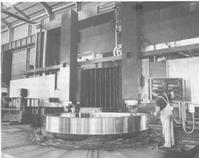


Chapter 12
I The First Half Century - The Initial Struggle
II The Second Fifty Years - The Start Of Expansion
III The Third Fifty Years - Federation And The First World War
i General Conditions
ii Some Early Innovative Approaches
iii Concrete Pipes
iv Cement-fibre Pipes
v Concrete Products
vi The Birth of the Iron and Steel Industry
IV The Fourth Period - Second World War To The Present
References
Index
Search
Help
Contact us

During the First World War, there was an acute shortage of axles, wheels and tyres for railway rolling stock and, largely on the initiative of Mr. Alfred Goninan of Newcastle, a new Company called Commonwealth Steel Products Company Limited was formed in conjunction with three Sydney foundries, the Clyde Engineering Company, Ritchie Brothers and Pioneer Spring Co. Ltd. Although set up in 1917, the Company did not begin production until after the war in 1919, at which time they were joined as a shareholder by Taylor Brothers and Co. Ltd. of Britain, who operated a large foundry there and were able to provide much technical and practical experience. In 1923, Vickers Ltd. of England, who had been a major supplier of wheels and axles to Australia before the war, became associated with the Company and the name was altered to Vickers Commonwealth Steel Co. Ltd. In 1930 BHP bought shares in Vickers Commonwealth Steel Co. Ltd. and acquired more in 1935 when a reconstruction led to the name being changed to Commonwealth Steel Company Ltd.
Mr. Alfred Goninan mentioned above, came to the colony around 1890 with a background in mechanical engineering gained in Cornwall, and at sea as a Chief Engineer. He first settled in South Australia and was partner in a small foundry in Port Pirie before moving to Newcastle as a permanent resident in 1899. The Hunter River district was an area of much commercial and engineering activity, particularly in the coal industry and he saw opportunities for providing coal skips and rail waggons. He first leased an older disused rolling stock works at Wickham and worked hard, building and extending his business, mainly in coal hopper waggons. From this beginning he branched out into a range of colliery equipment and built head-frames for some of the now renowned local collieries, such as Aberdare, and set up a new company, Engineers and Colliery Supplies, which still trades under that name in NSW As mentioned above, he was active in setting up Commonwealth Steel Products Company Ltd. which has now expanded to the multi-million dollar business Commonwealth Steel Company. He is also reputed to be the one who persuaded Henry Lane to come to Newcastle, initially to manufacture rabbit traps; a company that later expanded throughout Australia producing engineering hardware, locks and various household fittings.
The Goninan factory moved to its present site, 7 hectares at Broadmeadows, in 1919 where new works were erected, including a boiler shop, foundry including a brass foundry, pattern shop, blacksmith shop and machine shop and from where they produced such structures as 40 tonne billet shears for BHP, bridges for NSW Railways and steel housings weighing 50 tonnes each for the first BHP plate mill.
In the early fifties, Goninan began the manufacture of diesel electric locomotives of G.E.C. (USA) design, a field in which the Company specialized over the next 25 years, culminating in 1987 with the award of the contract by the NSW State Rail Authority to produce the TANGARA. This $500 million project is to produce a world class, high performance, smooth-skin construction train, making extensive use of glass and advanced electrical equipment that will require new levels of engineering excellence.
The ability to deal with very large machinery jobs was always a hallmark of the Goninan operations. In 1919 they purchased and installed a 3750 mm gear cutting machine; by 1973 they had installed the immense MAAG gear planer with a capacity of 7500 mm diameter wheels and some years later other equipment (see Fig. 3).

Organisations in Australian Science at Work - A. Goninan & Co.; Clyde Engineering Company; Commonwealth Industrial Gases Ltd (C.I.G.); Commonwealth Steel Company Ltd; Commonwealth Steel Products Company Ltd; Engineers and Collieries Supplies; N.S.W. State Rail Authority; Pioneer Spring Co. Ltd; Ritchie Brothers; Vickers Commonwealth Steel Co. Ltd
People in Bright Sparcs - Goninan, Alfred
 |
Australian Academy of Technological Sciences and Engineering |  |
© 1988 Print Edition pages 876 - 877, Online Edition 2000
Published by Australian Science and Technology Heritage Centre, using the Web Academic Resource Publisher
http://www.austehc.unimelb.edu.au/tia/855.html